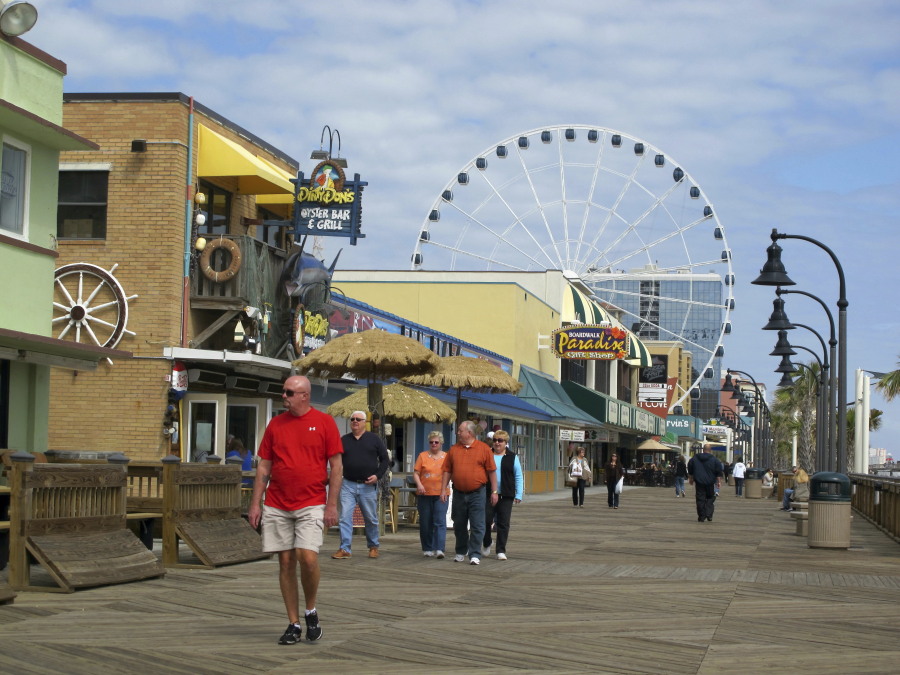A South Carolina beach town, once known for its lively nightclubs and strip joints under the nickname “Dirty Myrtle,” has transformed into a prime retirement destination. The Myrtle Beach metropolitan area saw a 6.3% increase in its senior population last year, making it the fastest-growing metro area for retirees in the United States, according to the latest U.S. Census Bureau data. Over the past decade, the senior population in Myrtle Beach has surged by more than 22%, the highest growth rate in the country.
Today, senior citizens constitute over a quarter of the approximately 413,000 residents in the metro area, which was historically recognized as a budget-friendly beach destination. The community, featuring a mile-long boardwalk and a 200-foot Ferris wheel, previously attracted boisterous biker rallies that the city attempted to curb in the late 2000s due to noise and congestion. Now, the once noisy streets have made way for quieter activities, including dining and pickleball courts.
The Pandemic’s Role in the Boom
The COVID-19 pandemic significantly contributed to Myrtle Beach’s appeal among seniors. Many individuals from states like Ohio and New York, who had long vacationed in the area, realized they could retire early or work remotely from anywhere, according to Mark Kruea, a former public information officer for Myrtle Beach currently running for mayor. “Many people converted that thought into action,” Kruea stated. “The climate’s great, taxes are low, there’s a wealth of opportunities for recreation, dining, and shopping.”
A Graying Nation
The growth in Myrtle Beach reflects a broader national trend. The U.S. population aged 65 and older increased by 3.1% last year, while the population under 18 decreased by 0.2%. Over the past two decades, the proportion of seniors in the U.S. has risen from 12.4% to 18%, while the share of children has dropped from 25% to 21.5%.
“As of 2020, Maine, Vermont, and Florida were the only states where older adults outnumbered children. By last year, this list expanded to include Delaware, Hawaii, Montana, New Hampshire, Oregon, Pennsylvania, Rhode Island, and West Virginia.”
Maine had the oldest median age at 44.8, while Utah was the youngest at 32.4, highlighting the demographic shifts across the nation.
Demographic Shifts Across the U.S.
In addition to the aging population, other demographic changes are reshaping the U.S. The Hispanic population reached 20% last year, driven by an annual gain of 1.9 million, primarily through migration. The largest numeric increases occurred in major metros like New York, Houston, and Miami, while smaller metros such as Ocala and Panama City in Florida experienced the highest growth rates.
For Black residents, growth was evenly split between migration and natural increase, with significant gains in Houston, New York, and Dallas-Fort Worth. Meanwhile, metro areas like Bozeman, Montana, and Provo, Utah, saw the highest growth rates for Black populations.
Asian population growth was most pronounced in New York, Dallas-Fort Worth, and Seattle, primarily due to migration. Smaller metro areas such as Farmington, New Mexico, and Bismarck, North Dakota, experienced the largest growth rates.
“The non-Hispanic white population in the U.S. saw a slight decline last year, but grew most significantly in Nashville, New York, and Charlotte. The highest growth rates were in Myrtle Beach, Daphne-Fairhope, Alabama, and Wilmington, North Carolina.”
Looking Forward
The transformation of Myrtle Beach into a senior haven is emblematic of broader demographic trends that are reshaping communities across the United States. As the nation continues to age, areas like Myrtle Beach may serve as models for how to accommodate and attract an older population. With low taxes, favorable climates, and ample recreational opportunities, these regions are likely to see continued growth among retirees.
As Myrtle Beach adapts to its new identity, city planners and local businesses will need to consider the needs and preferences of its aging residents. This includes expanding healthcare facilities, enhancing public transportation, and ensuring that the community remains vibrant and accessible for all ages.
 Scientists Use Smell to Unlock Secrets of Ancient Egyptian Mummies
Scientists Use Smell to Unlock Secrets of Ancient Egyptian Mummies US Stocks Drift as Wall Street Awaits Key Jobs Report
US Stocks Drift as Wall Street Awaits Key Jobs Report Bryan Kohberger to Plead Guilty in University of Idaho Stabbings, Avoiding Death Penalty
Bryan Kohberger to Plead Guilty in University of Idaho Stabbings, Avoiding Death Penalty Sean ‘Diddy’ Combs Acquitted of Major Charges, Faces Decade in Prison
Sean ‘Diddy’ Combs Acquitted of Major Charges, Faces Decade in Prison Hamas Open to Ceasefire as Netanyahu Rejects Role in Postwar Gaza
Hamas Open to Ceasefire as Netanyahu Rejects Role in Postwar Gaza